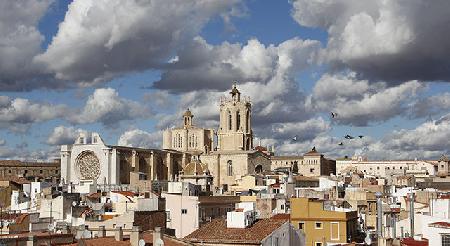Tarragona is an important city with a rich history, born from the arrival of Roman troops in the Iberian Peninsula in 218 BC, located on the Mediterranean coast, 94 kilometers from Barcelona. At the beginning of our era, Tarragona was known as Tarraco or Tarracona and was the provincial capital of the Roman Empire, which led to the construction of defensive walls, monumental structures and a Roman amphitheatre, circus and theater within the Provincial Forums. and Colonials. Today, the remains of Roman structures in the territory of the city of Tarragona form the archaeological complex of Tarraco, a site considered by UNESCO as a World Heritage Site since the year 2000.

Tarragona is a city where history and modernity are subtly intertwined, a city where beach holidays can be combined with visits to numerous historical sites and shopping.
Tarragona is the first large coastal city south of Barcelona. The city also offers a number of historical sites, including churches from several different periods and a well-preserved Roman Coliseum. The town itself has the usual array of Spanish squares dotted with cafes. Tarragona is a good option if you only have a day or two to get out of Barcelona, otherwise the beaches further south or the more remote coastal towns north of Barcelona offer a more unique experience.
The seaport of Tarragona consists of a commercial and industrial port, several marinas, a cruise port and the old part of the port, the fishing port. On the territory of the port there are several shopping centers and pleasure attractions, and the most attractive part of the port of Tarragona is the maritime neighborhood of El Serrallo, the old fishing port, a small area (formerly a fishing district) located on the west coast from the city.
Roman aqueduct:
No less spectacular is the Devil's Bridge in Tarragona, which is 217 m long and 27 m high. The building dates from the reign of Emperor Augustus in the 1st century AD, whose objective was to provide the Romans with drinking water. But according to legend, the bridge over the ravine was built by the devil to possess the soul of the man who will test the water first.
Today a park has been built around the aqueduct. But tourists are drawn to walk around the structure. The 9-story building offers an unbeatable panoramic view.
Roman circus:
The Roman Circus and the Tower of Pretoria, another ancient monument, built in a brilliant time when Tarragona was a majestic city under Roman rule. There is also the Tower of Pretoria on the territory of the Circus, where you can see the Gothic Hall. But this place will be interesting not only for lovers of antiquities, but also for all those who want to take a look at the whole of Tarragona and take impressive pictures, because from the height of the tower the best view of the historic center of the city is offered. . By the way, you can also take a look at the city from the "Balcony of the Mediterranean" - an observation deck that offers a beautiful view of the sea, the city and the ruins of the amphitheater. This is the first place where all tourists come to know Tarragona.
Tarragona Cathedral:
The Cathedral is one of the most beautiful buildings in the city from the Middle Ages. The cathedral is made in the Gothic style and represents a whole complex of buildings and structures. The territory of the cathedral includes a square, a chapel, a gallery and a museum. The building itself is decorated with statues of the apostles and a stained glass window in the form of a rose. There is a temple complex on a hill, the highest point of the city.
National Archaeological Museum of Tarragona:
The National Archaeological Museum of Tarragona was founded in the 19th century and is the oldest museum in Catalonia. The three floors of the building house a magnificent collection of sculptures, mosaics, weapons, tableware and money that have been found in numerous archaeological excavations. You can also visit one of the most interesting temporary exhibitions, which are held regularly in the museum.
Museum of Modern Art:
Art lovers can visit the art museum. Most of the collection are works by contemporary artists from Catalonia. There are also masterpieces of photography and the avant-garde era, interiors, furniture, small household items.
Paleochristian Museum:
At the beginning of the last century there was a boom in archaeological excavations in Tarragona. In the course of research, scientists discovered an ancient necropolis with many tombs, and near the cemetery they opened a museum, where you can see ancient ceramics, sarcophagi, sculptures.
Tarragona monasteries:
In the Tarragona area, more precisely at a distance of no more than one hundred kilometers from the city, you can visit rivers ancient monasteries, which were founded almost at the same time - in the XI-XII century.
